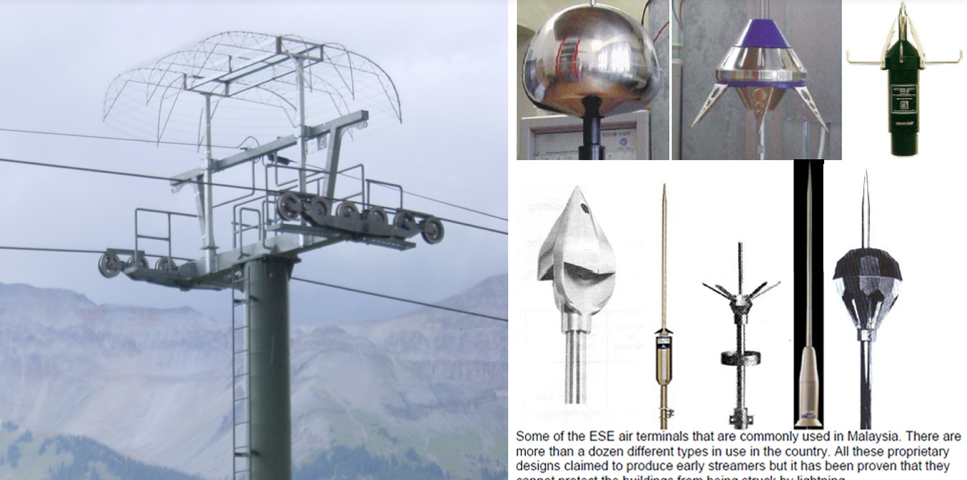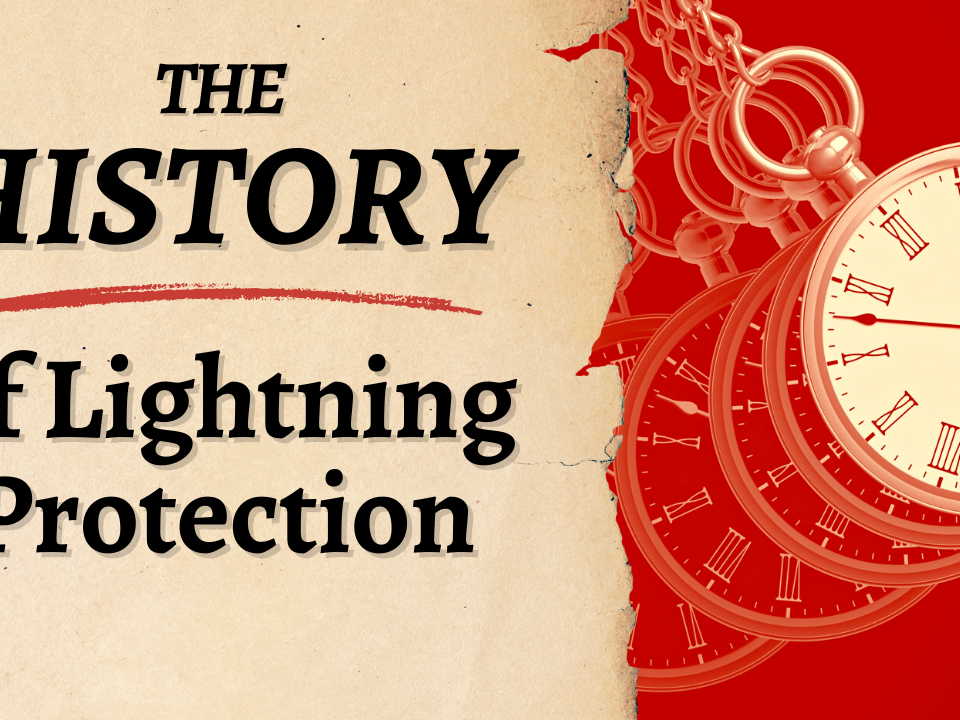- 100% AMERICAN MADE
- Lightning Protection - YOUR time, NOT Downtime

Lightning Rods are Old: NEW Lightning Protection Part 2
July 18, 2013
Overlooking Lightning Protection Can Cost You Millions
August 1, 2013Lightning Rods are Old: NEW Lightning Protection Part 3

By Lightning Diva@Large
The past two weeks we have discussed the how lightning works and taken a deep dive into the history of lightning rod protection. This week we will examine two modern lightning protection technologies.
One of the biggest misconceptions with the modern lightning protection technologies is that people believe an Early Streamer Emission (ESE) is the same as the Charge Transfer System (CTS). This could not be farther from the truth. Although both modern technologies are said to be more effective than the lightning rod, ESE works in a similar way, attracting the strike and inviting it into the environment much like a fox in a hen house. Not only does this invite potential primary damage, like an explosion or fire, it can and often will produce a ‘meantime between failure’ effect which impacts the life and functionality of equipment and electronics which is often not detected immediately, but definitely has a negative impact and can be extremely costly.
Roy Carpenter, a Chief Engineer for NASA’s Apollo Moon Landing Missions and the Space Shuttle design engineering teams, established Lightning Eliminators & Consultants in 1971 in order to study and apply engineering principles to lightning strike problems that they encountered frequently at Cape Canaveral. He took it upon himself to design a lightning strike prevention system based on physics and taking into account the scientific study of point-discharge rather than guess work or mere observation as had been the oversight of the lightning protection community for well over 200 years. The Charge Transfer Technology – the patented technology used in LEC’s Dissipation Array System (DAS) – works to reduce the rapid transfer of electrons that occurs with lightning into a slow drip by pushing storm-induced electric charge up into the atmosphere, above a protected site.
More similar to the conventional lightning rod, ESE systems are lightning attractors. However, according to their manufacturers, they are designed to trigger the early initiation of upward streamers, which increases the efficiency of lightning attraction as a way to extend the effective range of protection far beyond that of lightning rods. ESE air terminals can typically be distinguished from ordinary lightning rods due to the presence of a small object near the top, a discharge trigger, and they also can be more geometrically complex. This discharge trigger increases the probability for initiating a “streamer” discharge at or near the tip of the rod when an ionized “leader” approaches. Increasing the probability of streamers and leaders meeting is how ESE systems serve as improved lightning attractors. According to the National Institute of Standards and Technology, it is difficult to judge ESE performance: “It is nearly impossible to make quantitatively meaningful statements on the relative performance of ESE devices and conventional Franklin rods. In fact, sufficient reliable quantitative data on the performance of conventional rods seem not to exist.”
Charge Transfer System (CTS)
Unlike lightning “attractors,” CTS is specifically designed to prevent a lightning strike from terminating where it is not wanted—in a designated area of protection. This is the only system in which lightning strikes are actively discouraged, rather than encouraged. CTS technology is based on existing physics and mathematical principles. As noted by IEEE engineer Donald Zipse: “Proof of lightning rods’ effectiveness lies mainly in empirical and anecdotal evidence. CTS technology, however, is based on existing electrical and physical formulas and mathematical basics.”
In order to prevent lightning from striking within a specified zone, a CTS collects the induced charge from thunderstorm clouds within this area and transfers it through an ionizer into the surrounding air, thus reducing the electric field strength in the protected zone. The resulting reduced electrical potential difference between the site and the cloud suppresses the formation of an upward streamer. With no leader-streamer connection, the strike is prevented.
Dissipation Array System (DAS)
DAS is a specific type of CTS invented and produced by Lightning Eliminators & Consultants, Inc (LEC). Using a CTS “zone of protection,” a DAS is able to completely isolate facilities from a direct lightning strike by bleeding off the induced charge in the protected area during the course of a thunderstorm, reducing it to a much lower level in relationship to the surrounding environment. When the naturally occurring electric field in a protected area is reduced, the upward streamers are suppressed and do not get enough energy from a storm to connect with downward leaders—thus, no lightning.
In one study that LEC conducted at a customer site, electric fields inside the protected area during thunderstorms were, on average, 55% weaker than those in the surrounding area. Tri-State Engineering, which installed DAS in the 1990s, has had its system checked and re-certified by LEC on schedule. They have never had another direct lightning strike in the protected area since installing a DAS.
Differences in Lightning
Protection Technologies
Conventional lightning rods and ESE have one major aspect in common: they attract lightning. ESE terminals arguably differ in effectiveness—an ESE terminal is equipped with a device that increases the probability that an initiated upward streamer will connect with a downward leader. Increasing this probability means that lightning is more likely to strike the terminal rather than unwanted areas.
However, CTS offers an entirely different approach than either of those technologies: the key difference is one of attracting versus preventing lightning strikes. The approach is essentially the complete opposite. Rather than encouraging the attraction between streamer and leader, a CTS discourages it, thus preventing the formation of lightning strikes in the protected area as opposed to collecting them.
This fundamental difference can be key for industries such as oil and gas, midstream storage tank farms, and energy producers of all types. These facilities often have many flammables and other sensitive materials where using an attractor carries the risk of ignition or damage to electronic systems. As Zipse points out, “Is it wise to allow thousands of amperes to flow near sensitive electronics equipment, especially when charge transfer systems are available and can prevent strikes in protected areas?”4 However, this is also true for any operation that would have little tolerance for downtime. A single strike of lightning, or even a secondary surge, could restart the “Days since the last downtime event” clock. By utilizing prevention rather than attraction, CTS is the best option for facilities where a single spark could be catastrophic. LEC’s Dissipation Array System (DAS) is the only commercially available solution for creating this zone of protection that guards against a lightning strike.

